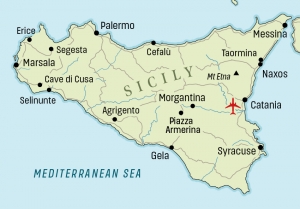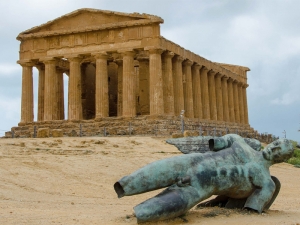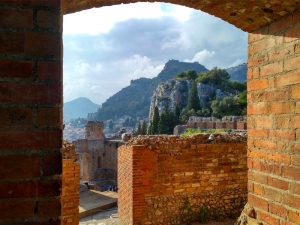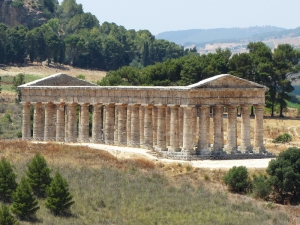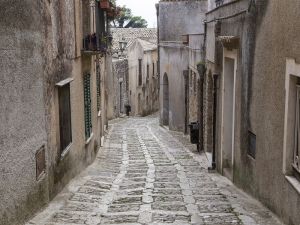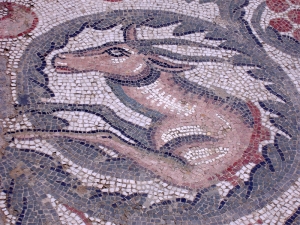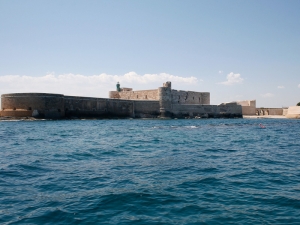
To be confirmed
Tour Introduction
Nowhere is the classical past more alive than on the beautiful island of Sicily. This wide-ranging archaeological tour will take us through a millennium of history from the early Greek colony of Naxos (734 BC) to the late Roman villa of Piazza Armerina (c.AD 320), with its world-famous mosaics. On the way we will explore the Valley of the Temples at Agrigento, the archaeological park and museum at Syracuse and the theatre at Taormina, with its breath-taking views of Mount Etna.
As Plato said, “Sicilians build things like they will live forever and eat like they will die tomorrow” which means that much of our tour requires a certain agility as we explore extensive remains often on our feet for a few hours at a time and an appetite to do justice to the local cuisine. But there will be plenty of time for recuperation as we listen to a series of in-situ talks which put each site in to its historical context.
Background
Sicilians call their island the House of the Sun. Throughout history its climate and fertile agriculture, combined with its strategic location, have drawn every major power in the Mediterranean to the island. The Greeks began their colonisation in the 8th Century BC. The wealthy and cultured cities they founded fought endlessly against each other, and against the Carthaginians who had settled in the west. The Romans arrived in the 3rd Century BC. Having vanquished the Carthaginians in the Punic Wars, Sicily became the first overseas province of the Roman empire. In the 2nd Century BC, the use of slave labour on great landed estates led to two revolts, each as cataclysmic as the more famous uprising of Spartacus. The riches of the island were a temptation to its Roman governors. Cicero, in his Verrine Orations, castigates the corruption and crimes of the most notorious. Under the rule of the emperors, Sicily settled down to become one of the wealthiest and most peaceful provinces of the Roman empire. Every step of the history of the island has left evocative archaeology for us to explore.
Highlights
- Spend a full day at Agrigento, exploring the magnificent Valley of the Temples, a UNESCO World heritage site
- Explore the Island of Ortigia
- Explore Selinunte Archaeological Park
- Visit the site of Segesta
- Explore Piazza Armerina, which contains the largest series of Roman mosaics still in situ
- Visit the Museo Archeologico Regionale Paolo Orsi
- Explore the mysterious catacombs of Latomia del Paradiso
- Explore the Archaeological site of Naxos
What's Included
- 4 Star Hotels
- Return flights from London (optional)
- Expert historians throughout providing a daily variety of talks, presentations and Q&A
- Dedicated Tour Manager
- Dinner parties hosted by your expert historians and tour manager
- The company of like-minded travelers
- Helpful and friendly travel advice
- Meals as indicated in the itinerary
- Two drinks i,e wine or beer at each dinner and a welcome drink on first evening
- Entrance fees for sites included in itinerary
- Tour information booklet
- Modern, comfortable, air-conditioned coach
"“Italy without Sicily leaves no image in the spirit: here [Sicily] is the key to everything.”"
Johann Wolfgang von Goethe (1749 – 1832)
Itinerary
Day 1: Depart: fly London to Palermo. Drive to Marsala and check-in to our hotel for three nights. (D).
Day 2: Selinunte: we visit Selinus (Selinunte), the most westerly of the Greek colonies where we spend the entire day exploring its Archaeological Park, one of the most expansive and incredible archaeological sites in the Mediterranean. (B, D).
Day 3: Segesta and Marsala: an early morning departure to the site of Segesta, one of the most important cities of the Elymians, an indigenous group of Sicily. Next, to Erice, where we make a generous stop for lunch to explore Erice (ancient Eryx) and enjoy magnificent views over Trapani. We finish the day at Marsala, where we visit the Regional Archaeological Museum Baglio Anselmi with its Punic Warship and archaeological remains which relate the tale of the Carthaginian stronghold of Lilybaeum. (B, D).
Day 4: Agrigento: we spend a full day at Agrigento, exploring the magnificent Valley of the Temples, a UNESCO World heritage site which is known for its unspoiled Doric temples dedicated to Greek divinities. This site has served as inspiration for many artists, poets and philosophers throughout history. We visit the Temple of Hercules or Heracles, the oldest Doric temple in Agrigento, from which Cicero claims the governor Verres attempted to steal the cult statue of the god. Hotel in Agrigento – 1 night. (B, D).
Day 5: Piazza Armerina (Villa Romana del Casale): an early start to the Piazza Armerina, a 4th Century AD villa, perhaps a hunting lodge of one of the emperors, which contains the largest series of Roman mosaics still in situ. Thence to Syracuse, where we check-in to our hotel for two nights.(B, D).
Day 6: Ortigia: explore the Island of Ortigia, the historical centre of Syracuse where we find the Greek temples of Apollo and Athena. We visit the Museo Archeologico Regionale Paolo Orsi, one of the principal archaeological museums of Europe and the Parco Archeologico della Neapolis with its Greek theatre, the mysterious catacombs of Latomia del Paradiso and the imposing Orecchio di Dionisios. Dinner is not included this evening and you are free to find your own restaurant. There is also the option to dine with your tour manager and historian at your own expense. (B).
Day 7: Taormina: we spend the morning at the Archaeological site of Naxos, the earliest Greek colony on the island, and its museum which houses finds from the ongoing excavations. Thence to Taormina to visit the Teatro Antico which dates from the 3rd Century BC, the “small theatre” or Roman Odeon and the Naumachia di Taormina, a Roman wall with 18 niches dating from the 1st Century BC. Hotel in Taormina – 1 night (B, D).
Day 8: Return: drive from Taormina to Catania Airport for our return flight to London. (B).

